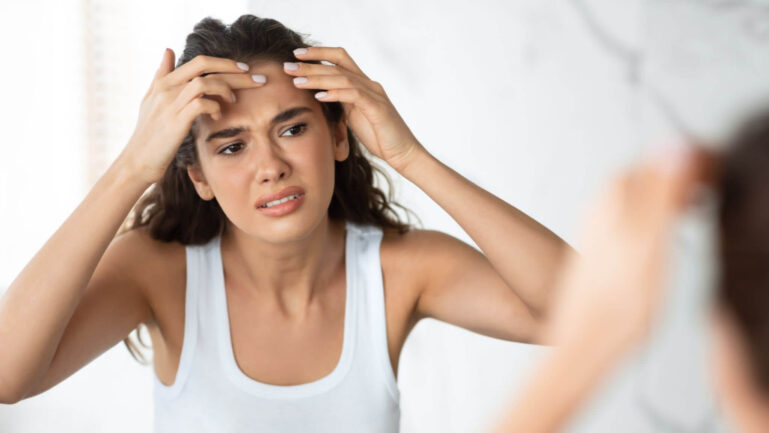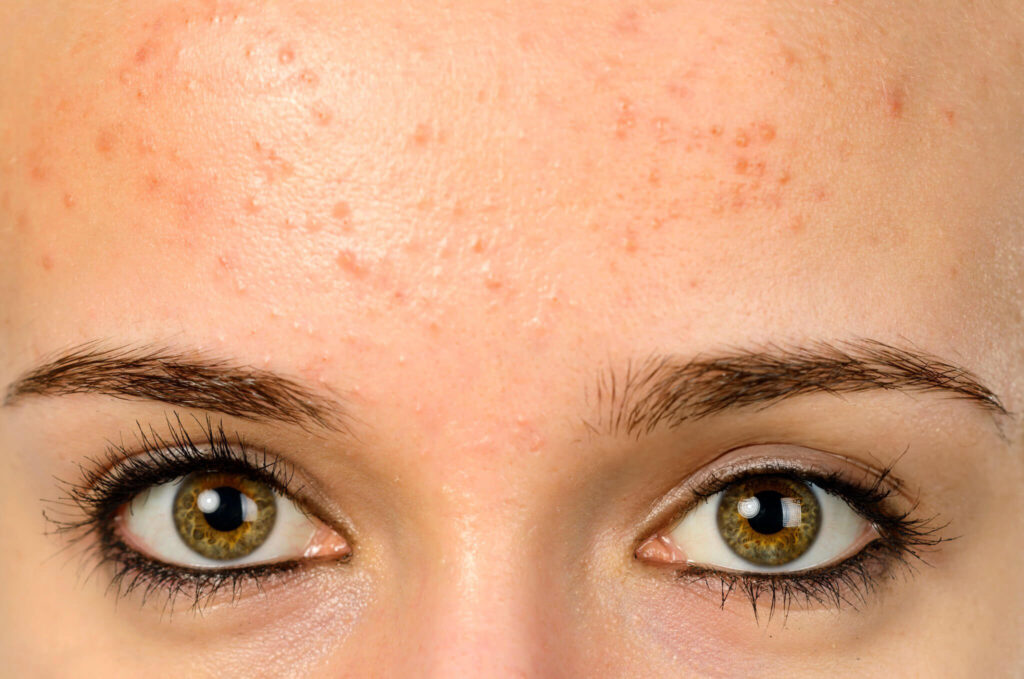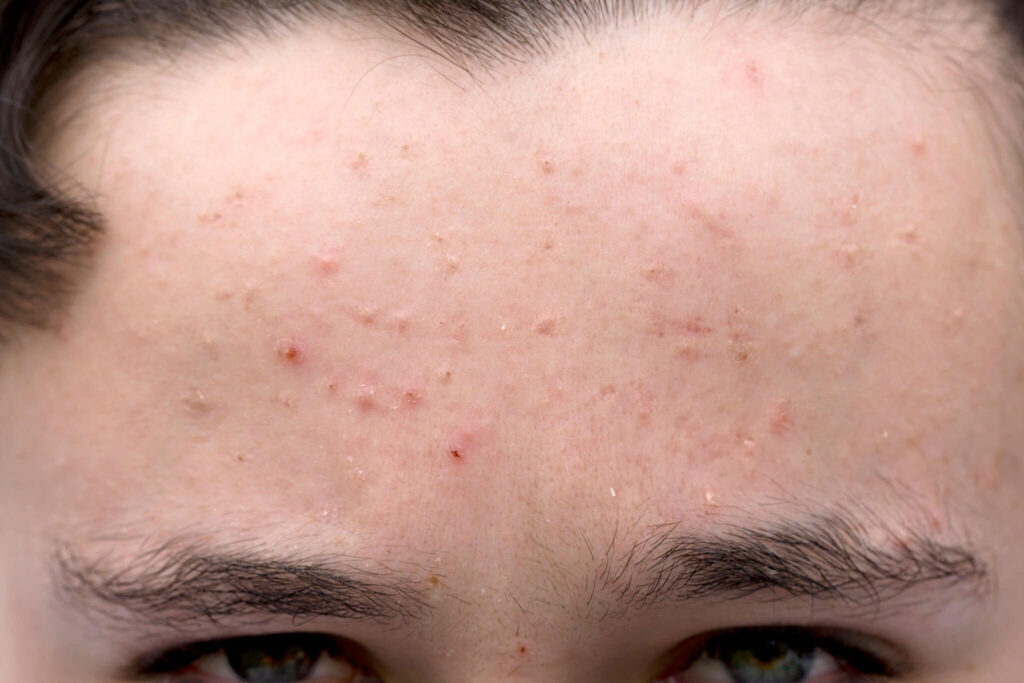Acne

It is common for people to be confronted with blemishes on the forehead at some point in their lives. While some people also struggle with blemished skin in other areas of the face, for others this is limited to the forehead. These skin blemishes can be annoying, but they are a natural and harmless condition.
There are various signs of forehead pimples. Inflamed areas frequently occur, leaving red and unpleasant spots. This is often accompanied by excessive sebum production, which can clog the pores and thus promote the formation of spots. Blackheads can also appear, making the skin look uneven and rough. Another symptom can be painful pimples, especially if they are deep in the skin or inflamed.
There are numerous causes of spots and blemishes, from oily hair to hormonal changes. In addition, pimples on the forehead can vary in appearance.
The forehead is one of the areas of the face most frequently affected by spots. This is due to the T-zone, which includes the forehead. The skin in this area often tends to produce more sebum, which increases the risk of clogged pores and thus pimples.
The development of pimples on the forehead is caused by the skin bacterium Propionebacterium acnes, which feeds on skin oil. The breakdown of this skin fat produces waste products and fatty acids that irritate the sebaceous glands and can trigger inflammation.
Initially, red, inflamed nodules may appear, which later develop into pimples with broken down skin fat. Although this may sound worrying at first, it is a normal process. In most cases, pimples disappear by themselves after a few days. In some cases, however, it can take several weeks for them to subside, depending on the individual.
The appearance of blemishes on the forehead can vary. They can appear in the form of blackheads or whiteheads. Despite their diversity, they are a normal skin condition.
Pimples on the forehead can be both superficial and deep-seated. A typical pimple appears as a red bump, often filled with yellow pus. There are also subcutaneous pimples, which can appear as small, inflamed bumps in the skin.

If pimples appear on the forehead, this can be due to various causes. In fact, many people suffer from forehead pimples at some point, as this area of the skin often produces more sebum than other parts of the face. This creates ideal conditions for pimples to develop.
There are various triggers for pimples on the forehead:
One factor may be genes, which make you more prone to spots on your forehead. Heredity plays an important role and a predisposition to blemished skin or acne can be genetically determined. So if one parent suffered from acne or pimples, it is likely that the offspring will too. Oily skin and skin impurities often go hand in hand, which is why thorough skin care is of great importance.
During puberty, many teenagers develop pimples on their forehead, as the body produces more of the male sex hormone androgen during this phase. This applies to both boys and girls.
Hormones have a significant influence on the condition of the skin. Imbalances in hormones can manifest themselves through the skin, which can lead to many pregnant women developing skin blemishes.
Stress can not only affect our mental well-being, but can also have physical consequences. Stress can cause inflammation in the body, which in turn can lead to pimples. Many people are exposed to stressful situations, which puts a strain on the body and can lead to spots on the forehead.
The frequency of spots on the forehead is due to the fact that the skin in the T-zone (forehead, nose and chin) produces more sebum than in other areas. Oily hair can also cause pimples, as the hair grease can get onto the forehead and lead to clogged pores and blemishes. It is important to choose hair products that do not promote a greasy hair texture.
The pores in the T-zone, including the forehead, are often more noticeable as blackheads frequently form there. Blackheads are caused by an overproduction of skin oil and can lead to pimples. Regular cleansing of the skin is important to prevent blemishes in the T-zone.
A balanced diet is important as this provides the body with the best conditions. Although there are no direct studies proving a link between poor diet and spots on the forehead, eating dairy products can promote blemishes.
External factors such as wearing hats or using hair wax can also lead to spots on the forehead. Hair products can get onto the skin and cause irritation, excess oil or bacteria build-up, which clogs the pores. It is therefore important to choose both headgear and hair products carefully and to clean them regularly. Breathable materials such as wool, cotton and silk are recommended for headwear.
Are you affected by stubborn pimples on your forehead? Here are some useful tips that you can use in addition to your usual skincare routine.

In addition to these tips, there is the innovative product SkinCare Acne, which uses bacteriophages to combat pimples on the forehead. Bacteriophages are viruses that can selectively attack and kill bacteria without affecting other cells. By targeting the skin bacterium Propionebacterium acnes, SkinCare Acne can help to effectively remove spots and promote clearer skin.
Have you ever noticed that pimples appear on your forehead and can aggravate your skin problems? Don’t worry, you’re not alone! The forehead is often a problem area for spots, but with the right skincare you can keep them at bay and enjoy radiant skin again.
First of all, it is important to understand why pimples appear on the forehead. Excess oil, dead skin cells and bacteria can accumulate in the pores and lead to blemishes. An effective first step is therefore to gently cleanse your skin in the morning and evening. Use a mild cleanser that does not dry out the skin, but at the same time thoroughly removes excess oil and dirt.
After cleansing, moisturizing is an important step. Choose a light, oil-free moisturizer that will hydrate your skin without clogging pores. Make sure it is non-comedogenic so that it does not clog your pores further and prevents the formation of new spots.
Another important aspect is regular exfoliation. By removing dead skin cells, you can prevent them from accumulating in the pores and causing pimples. However, avoid excessive exfoliation as this can irritate the skin and increase inflammation. Gentle exfoliation once or twice a week should be sufficient.
In addition, using products with ingredients such as salicylic acid or benzoyl peroxide can help to combat spots and clear the skin. These active ingredients help to reduce excess oil and cleanse the pores, which helps to prevent spots and treat existing blemishes.
Remember that consistent skincare is key. Be patient and stick to your routine, even if it may take some time before you see results. However, if your pimples are persistent or worsening, it is advisable to see a dermatologist who can help you develop a personalized treatment strategy.
With the right skincare and a little patience, you can get the spots on your forehead under control and achieve clearer, healthier skin.

When it comes to pimples on your forehead, it can be tempting to immediately reach for home remedies to get rid of them. But caution is advised! Some of these supposedly harmless home remedies could even make your skin problems worse. Find out here which home remedies you should avoid to keep your forehead pimple-free.
Instead of using these potentially harmful home remedies, opt for gentle, dermatologically tested products that are specifically designed to treat pimples. A good cleansing, moisturizing and targeted treatment with ingredients such as salicylic acid or benzoyl peroxide can help keep your forehead clear and pimple-free.
Always remember that skincare is individual and what works for others may not necessarily work for you. If you are unsure, consult a dermatologist to find the best treatment for your skin.
Pimples on the forehead can be caused by various factors, including excess oil, dead skin cells, hormonal changes, stress and even the wrong skin care products. The forehead is particularly prone to pimples due to the high concentration of sebaceous glands in this area, which can lead to clogged pores.
Gentle and consistent skin care is crucial for spots on the forehead. Cleanse your skin twice a day with a mild cleanser, use oil-free moisturizers and exfoliate regularly to remove dead skin cells. Avoid touching or squeezing the pimples, as this can lead to inflammation and scarring.
Stress pimples on the forehead can manifest as small, red bumps or as acne breakouts. They can occur individually or in groups and are often associated with increased stress levels. Stress can affect the production of hormones that increase sebum production and can lead to pimples.
Some home remedies can help to treat pimples on the forehead. These include the use of tea tree oil, which has anti-inflammatory properties, the application of honey masks to soothe the skin and the use of aloe vera gel to reduce redness and inflammation. However, it is important to use these home remedies with caution and to consult a dermatologist if you have sensitive skin.
It is strongly advised not to squeeze out pimples on the forehead. Squeezing pimples can lead to infection, inflammation and scarring. It can also promote the spread of bacteria on the skin and lead to further outbreaks. It is best to let pimples heal naturally or, if necessary, ask a dermatologist for professional treatment.
Author: Martin Müller
“Various internal and external influences can cause our microbial balance to become unbalanced. Harmful bacteria get out of hand and skin irritations such as redness, itching and eczema are the result. “
Share post: